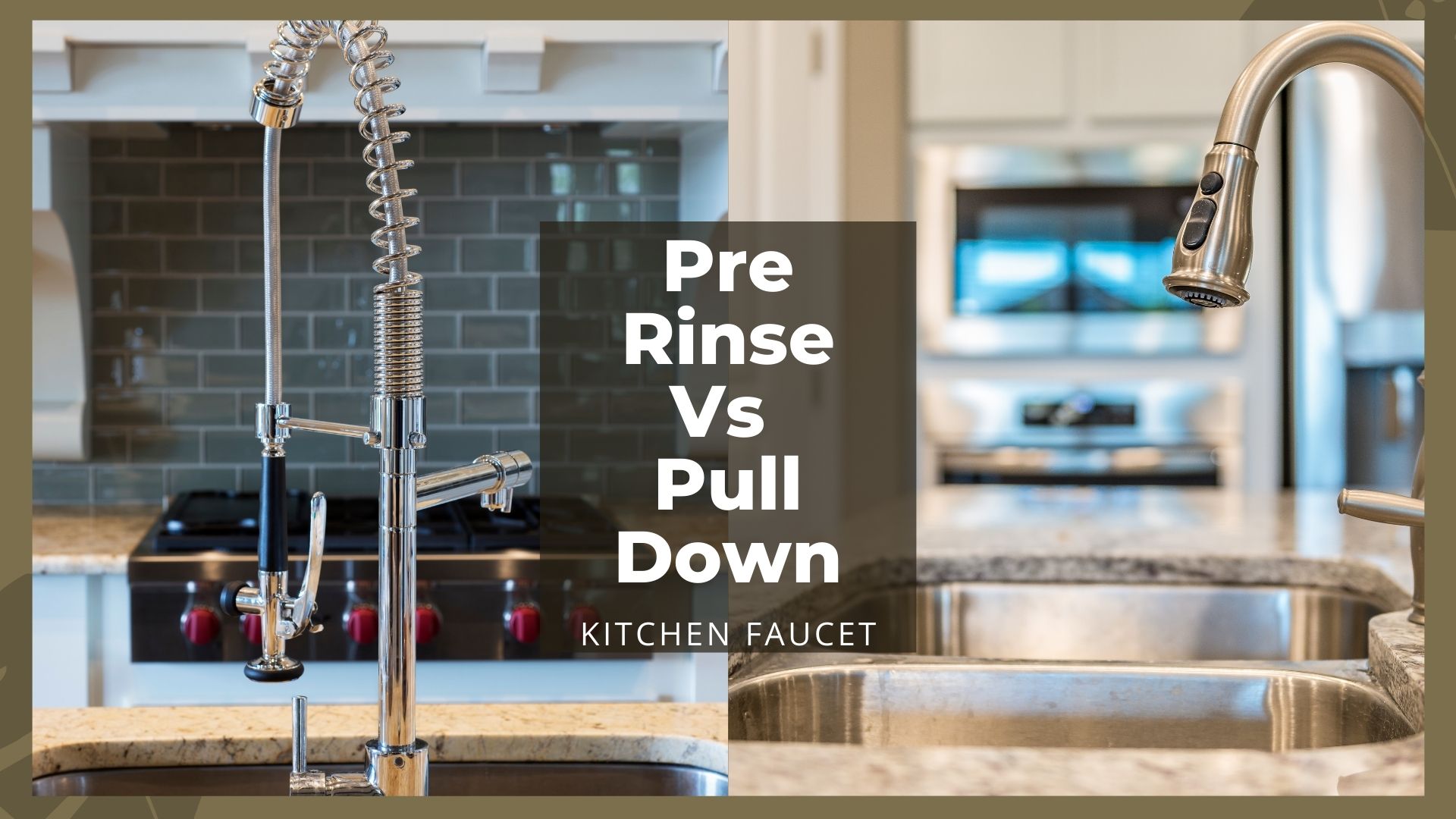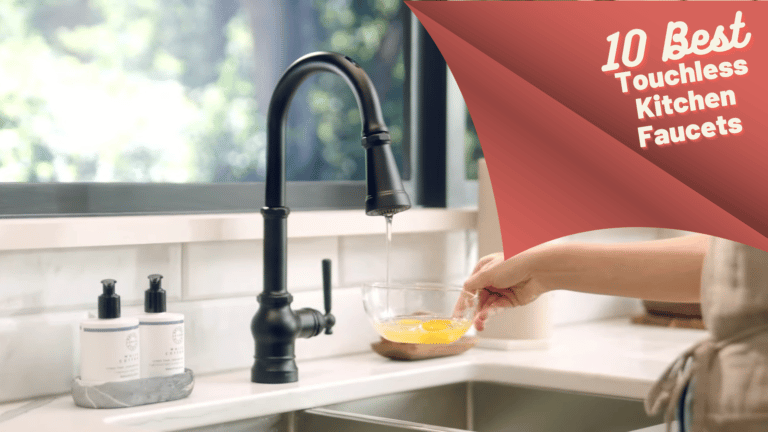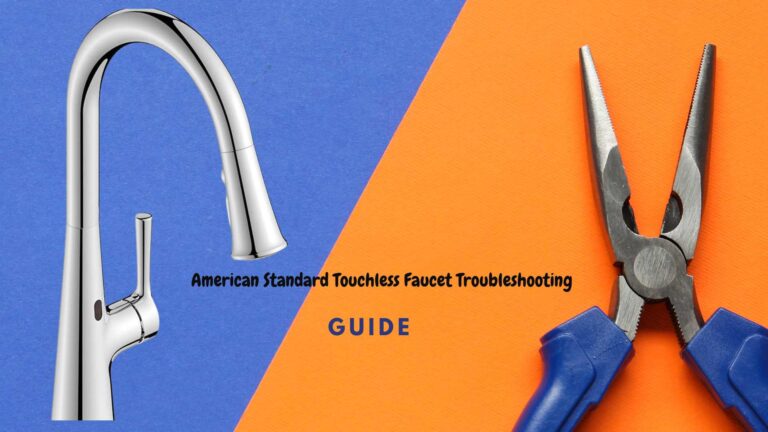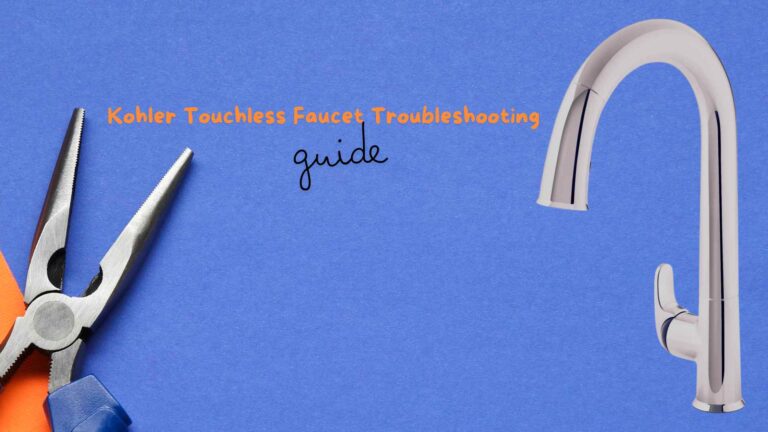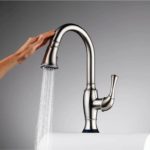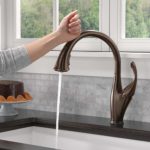Let’s start with the big question. Pre Rinse vs. Pull Down — which should I choose? To be honest, before we started researching for this article, We didn’t even knew how to differentiate between the two! But during the research, We found that there are some critical differences between two faucet styles – Pre Rinse vs. Pull Down. This article will focus on how ”Pre Rinse” and ”Pull Down” faucets compare and contrast. Hopefully, you will find this information helpful when you go to choose a new kitchen faucet in the future.
The pre-rinse faucet is generally considered to be the best option for commercial kitchens. However, if you have a tight installation area or a double tub sink, a pull-down faucet will give you greater flexibility. This is especially true when large pots, pans, need to be cleaned.
Let’s take a closer look at the pros and cons of each style.
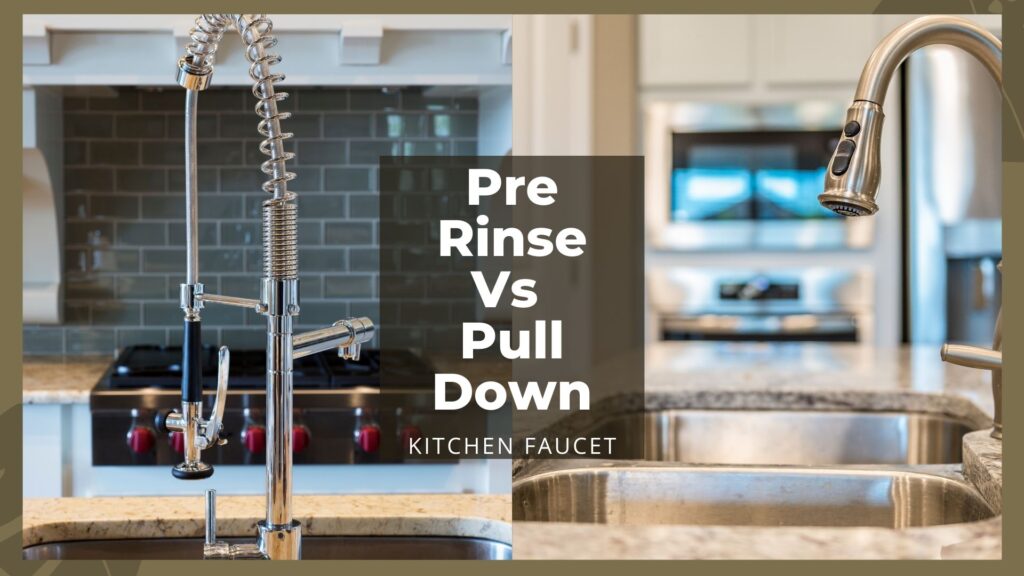
Pre Rinse vs. Pull Down Faucets – What is the difference?
Pull-down faucets can be found in many home kitchens, where the design is known for its sleek and seamless appearance. A pre-rinse faucet, on the other hand, is a commercial kitchen staple. While both faucets are similar in function, there are some notable differences between them.
Both pre-rinse and pull down faucets have several similar elements.
- They typically have a high arch spout, which allows for easy access to the sink basin.
- Both faucet types are designed for commercial kitchens and are great for home use as well.
- They both offer a spray head that allows you to easily clean dishes and vegetables, as well as fill large pots and pans with water.
- Both of them have an aerated stream or spray setting, which allows for filling glasses, washing hands, and other tasks.
- They both feature a pull-down hose that makes it easy to reach every corner of your sink basin.
What sets them apart?
- A pre-rinse faucet has a tall spout, up to 18 inches tall, allowing you to reach into the sink and rinse dishes easily.
- A pull-down faucet has a shorter spout, usually between 6 and 8 inches. The pull-down feature makes it easier to get under the faucet for cleaning.
- The design of pre-rinse faucets is more tactile than pull-down models. With a simple handle or lever, it’s easy to determine whether you are turning the water on or off just by touch.
- Pull-down faucets often have a single handle that controls both water temperature and flow. These models have an integrated spray nozzle that can be pulled down from the faucet for greater control when rinsing dishes.
- Most pre-rinse faucets operate via manual levers or handles, but some models feature a single handle with a joystick design to turn on and off effortlessly.
What is a Pre Rinse Faucet?
A pre rinse faucet is a type of kitchen or restaurant faucet designed to make it easier to wash dishes and prepare food. Pre-rinse faucets usually have long, flexible hoses that attach to the spray nozzle, which is held in place by a spring-loaded arm. The arm swivels back and forth and has an ergonomic handle that allows for a good grip, making it easy to maneuver the nozzle into awkward spaces and direct water where it is needed. Some pre-rinse faucets have a spray head that can be locked in place so the water comes out in a steady stream instead of spraying. The most obvious difference between a pre-rinse faucet and a standard kitchen faucet is size. A typical pre-rinse faucet has a spout that’s 12 inches (30 cm) or more high, while many residential kitchen faucets have spouts that are only 8 inches (20 cm) high. The larger size accommodates the taller commercial sinks used in most commercial kitchens, but it also makes the spout easier to use because it allows plenty of room for big pots, pans, and other cookware underneath. Pre-rinse faucets are often wall mounted. Traditional commercial faucets are way too big for residential installments, but a few notable faucet brands have created smaller versions for home kitchens that keep the basic design elements and functionality of the larger pro versions.

Pros an Cons when choosing a Pre Rinse Kitchen Faucet
While these faucets are typically used in commercial kitchens, they’re making their way into residential homes as well. Let’s see what are the advantages and disadvantages of having a pre rinse kitchen faucet.
The Pros
- Impressive Design: These faucets add a modern touch to any kitchen setup, with their high-arcing spouts that provide more space for washing dishes or filling containers with water. The height is perfect for a deep sink and the installation is simple.
- Cleaning power: The strong spray from these faucets makes it quick and easy to clean large pots and pans or other dishes. There is no better solution when it comes to cleaning greasy dishes than using a pre rinse faucet with its spray valve that releases water at high pressure. It is also easier to do things like rinsing off the cutting board or removing food particles from large pots and pans.
- Tall Height: This type of faucet is tall enough to work well with deep sinks or even farmhouse sinks (with the right accessories).
- Quality build: Commercial grade pre-rinse faucets are made from the best materials and are very durable. They can withstand thousands of hours of use and abuse, which is why we see them in restaurants. They are made from stainless steel, brass, ceramic mixing valve and cast brass body ensuring durability in harsh environments.
The Cons
- Water efficiency-wise: As pre-rinse faucets tend to spray water, they require a higher water pressure. This means that they end up using more water than a traditional faucet.
- Installation is another factor to consider: If you are replacing an old faucet, you should make sure that your new one is compatible with your sink. Most manufacturers will provide this information on their website or in their product manual. The last thing you would want is to have your faucet delivered only to find out that it doesn’t fit in your sink!
- Not suitable for tight spaces: In addition, the pre-rinse faucet is definitely going to take up more space than the traditional faucet. This makes it unsuitable for people who have small kitchens or limited space on their sinks.
- Quite expensive: Pre-rinse faucets are not that commonly found in households and as a result, they tend to be quite pricey. The extra features that it comes with also make it more expensive.
What type of Pre Rinse Faucet should I choose?
Pre-rinse faucets typically come in two mounting styles: wall-mounted and deck-mounted. Each style serves its own purpose depending on your setup.
Wall-Mounted
Wall-mounted faucets are great for saving space. They’re a bit more difficult to install but less visible, so you can conserve your sink and counter space for other things.
Deck-Mounted
Deck-mounted faucets are more convenient to install. Since they are built on top of the counter, they are much easier to access, especially if you have a large sink. With a deck-mounted pre-rinse faucet, you can easily adjust the height of the spray head. If you’re having trouble deciding which pre-rinse faucet to choose, here are a few things to consider: How Will It Be Used?—Determine how often the faucet will be used. If you operate a busy kitchen that requires frequent rinsing, choose a high-quality product that can withstand daily use. What Spray Valve I Need?—While all pre-rinse units come with various GPM options, some models have more to choose from than others. For example, the CWM Commercial pre-rinse unit offers 1.42 and 2.2 GPM options for the spray valve, while the T&S Brass pre-rinse unit gives you 11 different choices. Ease of Use—Look for something that’s comfortable and easy to use. Some units also come with an add-on faucet option that allows you to install a regular faucet instead of using the spray valve each time.
In addition to Pre Rinse Faucets, there are also Touchless options for your home
Delta Pre-Rinse Touchless Faucet
APPASO Pre-Rinse Touchless Faucet
Moen Pre-Rinse Touchless Faucet
Price on Amazon
Pre-rinse faucets are must-have items in commercial kitchens, and they’re also becoming more popular in residential settings. While they offer convenience, they can be intimidating — not only in terms of functionality and features but also because of their large size. To help you consider this option for your home kitchen, we’ve identified several small pre-rinse faucets available with touchless options. They come in semi-pro sizes to fit your home kitchen, and they deliver high-pressure water that can power through food residue on pots and pans in your sink.
What is a Pull Down Faucet?
The term pull-down faucet describes a type of kitchen faucet that is counter-mounted and features a spray head that extends downward from the end of the faucet. The spray head can be pulled down and out of the faucet or, on some models, it can be pulled down and then moved to other positions. These types of faucets usually feature single-handed operation and they are considered ideal for kitchens with large sinks – particularly double bowl sinks – as their high arcs allow for plenty of clearance between the sink bowls. Pull down faucets have grown in popularity over the past decade due to their stylish designs and useful functionality. For example, many pull downs feature one or more spray patterns, which are often controlled via a button on the spray head itself. Some also offer pause functions, which allow you to pause the flow of water without having to turn it off completely. Others offer extended ranges, using longer hoses or spout extensions to provide increased reach at the sink.

Pros an Cons when choosing a Pull Down Kitchen Faucet
While a pull down faucet has its advantages, there are also some disadvantages that you need to consider before purchasing one. Here are some of the pros and cons of pull down kitchen faucets:
The Pros
- Ergonomic Design: Pull down faucets look great in any kitchen and they are also designed ergonomically compared to other types of faucets. The spout is usually flexible so you can reach all parts of your sink with ease.
- Many Spraying Options: Most pull down faucets come with different spraying options such as spray patterns and various water flow settings. You can mix or stream water depending on your needs.
- Ideal for Filling and Rinsing: Pull down faucets are very useful in the kitchen, they provide you with the ability to clean and wash large dishes easily. Pull down faucets have a long hose that will allow you to fill large pots with water or be able to reach your entire sink.
- Perfect for Deep Sinks: Pull-down faucets with sprayers work great with deep kitchen sinks, so if you have one, you can certainly use them. Deep sinks have become quite popular because they can easily hold large pots and pans without any problems, but, with a regular sink, it is impossible to clean your cookware without using the sprayer
The Cons
- Splashing Problems: One disadvantage is splashing in shallow kitchen sinks. If you have a shallow sink, the water from the spray head will splash back up onto your clothes and the countertop around it.
- Height Issues: Can be too tall for certain kitchens – if your cabinets sit low on your countertop you may have an issue with clearance.
- Hose Lenght: A pull down spout can only extend so far away from the faucet itself. This could be an issue if you have a large kitchen or especially large pots and pans that you need to wash with your sink sprayer.
- Docking Issues: One final con is that on the cheap pull down options the spray head doesn’t dock properly hanging out of the spout. If this happens water will drip from the spout and make a mess.
How to choose a Pull Down Faucet?
Pull down faucets are one of the most demanding tools in your kitchen. If you have ever used a pull down faucet, you would know how useful and wonderful they are. However, there are many things to consider when buying one. You should think very carefully before deciding which pull down faucet is right for your kitchen. In our everyday life we use the faucet dozens of times. This is why it needs to be a high-quality, durable and versatile tool. The design of your faucet should be in line with the design of your kitchen or bathroom. There is a wide range of styles and materials so choose the one that fits your needs and taste. The type of handle can be divided into two groups: single-handle and dual-handle. The first one is more suitable for small kitchens where you have limited space to work with. It looks great, but if you have children it will be hard for them to reach the handle. The dual-handle faucet has separate handles for hot and cold water, so you can easily control the temperature. Another important aspect is the height of your faucet which is measured from the base to the top of the spout. If you have a small sink, then choose a low arc pull down faucet which will give you more space to move around your sink. On the other hand, if you have large sinks, then opt for one with high arc.
More and more pull down faucets are coming with features like touch-free activation. Below are a few examples.
Kohler Pull Down Touchless Faucet
Delta Pull Down Touch2O Faucet
Moen Pull Down Touchless Faucet
Price on Amazon
These new faucets can be activated by the wave of your hand or wrist and makes daily tasks in the kitchen more convenient.If you find yourself frequently doing dishes while your hands are covered in food, a touchless pull-down faucet could be helpful. It allows you to use the faucet without ever having to touch it, so you won’t risk spreading germs around on the handle.
Would you like to know more about different types of faucets? Read our Touch vs Touchless Faucet Comparison Guide.
Pre Rinse vs Pull Down Faucet – Final Verdict
So, which do you prefer: a pull down vs pre rinse? Well, the decision is ultimately up to you. The pull-down faucet is a good all-around choice, and it doesn’t require the additional space needed for a pre rinse model. But if you have the extra space, go with the pre rinse. As with most things in life, sometimes more room allows for more freedom of movement.
Considering the many factors that go into sink design, it’s clear that choosing the right faucet is really a matter of personal preference. Just because one type of faucet happens to be better than another one in one regard doesn’t necessarily mean it will be a better choice overall. This means that you should take some time to think about what you want and which faucet will give you those features before making a purchase.

